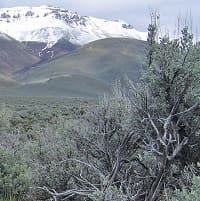Sage-grouse
Function over form: The benefits of aspen as surrogate brood-rearing habitat for greater sage-grouse
View article.
Species of conservation concern are often habitat specialists, posing significant risk to those species when specific plant communities are threatened. As a result, practitioners habitually focus conservation efforts on these communities while ignoring ecological mechanisms that explain the wildlife–plant relationships. In doing so, practitioners may overlook alternative vegetation communities that could maintain wildlife populations under alternative conditions (e.g., climate change). Here, we term these areas surrogate habitat, defined as vegetation communities or resource sites that provide similar critical resources as conventional sites, and assess their potential for conservation using a case study of greater sage-grouse on Parker Mountain, Utah (1998–2009). Sage-grouse are a sagebrush-obligate species and a species of conservation concern. Range-wide conservation efforts have long emphasized management of seasonal habitats within semiarid sagebrush ecosystems, specifically management of mesic or wet meadow sites that provide brood-rearing habitat required for population persistence. Despite this requirement, no conventional mesic habitat exists on Parker Mountain, yet it supports one of Utah’s largest sage-grouse populations. Rather, the Parker sagebrush system abuts quaking aspen (Populus tremuloides) stands that may provide brood-rearing habitat analogous to wet meadow sites. It is unclear, however, to what extent sage-grouse use these aspen stands because sage-grouse commonly avoid tall structures (e.g., trees) and their associated avian predators. Thus, we tested whether (1) sage-grouse selected for surrogate habitat (i.e., aspen edge) and (2) selection behaviors related to surrogate habitat had demographic effects on the population. As we predicted, sage-grouse selected for these areas, and the sage-grouse that spent increased time closer to aspen edges did not experience increased mortality. Together, this demonstrates that the aspen–sagebrush edge provided a surrogate for the wet meadows used by other populations. More broadly, this suggests that conservation practitioners should move beyond simplistic wildlife–habitat associations toward a more holistic view of animal ecology focused on the wildlife–resource association, an approach that becomes particularly useful in areas where conventional obligate habitat may be degraded or lost. This work also implores us to examine alternative habitat potential rather than applying one-size-fits-all models to threatened species conservation.
The US Geological Survey Land Management Research Program and the Great Basin Fire Science Exchange teamed up to bring you updates in sagebrush, fire, and wildlife related research.
Dates, Topics, and Presentations:
1/30 – Sage-grouse, carbon topics
Webinar recording
Summary webpage
Program with speakers, talks, and resources
- Greater sage-grouse hierarchical population monitoring framework: Range-wide application of an early warning systems for populations at-risk – Coates, Weise et al.
- Evaluating the effectiveness of conservation actions directed for greater sage-grouse using hierarchical models and the Conservation Efforts Database – Coates et al.
- Greater sage-grouse range-wide seasonal habitat maps: Identifying regional thresholds and relationships between trends and seasonal habitat use – Wann et al.
- Characterizing the environmental drivers of range-wide gene flow for greater sage-grouse – Zimmerman et al.
- Characterizing greater sage-grouse climate driven maladaptation – Zimmerman et al.
- Quantifying carbon storage and greenhouse gas emissions in sagebrush rangelands to inform management for carbon resilience – Bagcilar et al.
2/6 – Invasive species, restoration effectiveness, and monitoring
Webinar recording
Summary webpage
Program with speakers, talks, and resources
- Develop annual herbaceous percent cover maps in near-real time – Boyte et al.
- Proliferation of fine fuels: Assessing under future climatic conditions – Roche et al.
- Optimizing sagebrush restoration and management actions to increase connectivity within the Sagebrush Conservation Design – Tarbox et al.
- Assessing cheatgrass treatment efficacy across the sagebrush biome – Tarbox et al.
- Simulating trends in land health components under treatment scenarios and Sagebrush Conservation Design – Christensen et al.
- Biome-wide vegetation change monitoring and warning system – Aldridge et al.
- Vectors of annual grass invasion – Roche et al.
- Predicting reburn risk to restoration investments – Applestein et al.
2/20 – Monitoring, pinyon-juniper, and fuels management
Webinar recording
Summary webpage
Program with speakers, talks, and resources
- Planning for conservation delivery success: Linking biome-wide Sagebrush Conservation Design to local treatment planning by leveraging landscape restoration outcomes- Arkle et al.
- Technical transfer tools for the Nevada and Oregon rangeland monitoring project (NORMP) – Pilliod et al.
- Rapid and Other Assessment and Monitoring Methods (ROAM) project – Jeffries et al.
- Pinyon-juniper treatments for minimizing climate and fire vulnerability – Noel et al.
- Synthesis and forecasts of pinyon-juniper woodland die-off – Wion (No recording)
- Synthesizing scientific information on treatment and natural disturbance effects on pinyon-juniper woodlands and associated wildlife habitat – Halperin et al.
2/27 – Fire, fuels management, invasive species –
Webinar recording
Summary webpage
Program with speakers, talks, and resources
- Effectiveness of layering treatments in the “multiple-intervention” response to wildfire in sagebrush steppe – Germino et al.
- A collaborative and iterative framework for delivering applied fuel break science: With a focus on sagebrush ecosystems and the Great Basin – Shinneman et al.
- UAS survey of sagebrush fuel breaks – Shinneman et al.
- Invasive annual grass – Economic assessment – Orning et al.
- Longevity of herbicides targeting exotic annual grasses in sagebrush-steppe soils – Germino et al.
- Synthesis of indaziflam outcomes for protecting sagebrush ecosystems – Roche et al.
- Can ruderal components of biocrust be maintained under increasing threats of drought, grazing, and wild horses? Condon et al.
3/6 – Climate, vegetation trends, and big game
Webinar recording
Summary webpage
Program with speakers, talks, and resources
- Rangeland Condition Monitoring Assessment and Projection (RCMAP) vegetation trend summaries – Rigge
- Integrating climate, sagebrush ecological integrity, and grazing – Holdrege et al.
- Influence of future climate scenarios on habitat and population dynamics of greater sage-grouse – O’Neil et al.
- Understanding and forecasting environmental controls over plant establishment in sagebrush ecosystems to enhance restoration success – Siegmund, Stears et al.
- Treatment and post-fire assessment tools for management of the sagebrush ecosystem – Duniway, Tyree et al.
- Science to support elk management efforts to reduce CWD risk – Janousek et al.
View article.
Using the Gunnison sage-grouse as a case study, we leveraged existing resource selection function models to identify areas of high restoration potential across landscapes with variable habitat conditions and habitat-use responses. We also tested how this information could be used to improve restoration planning. We simulated change in model covariates across crucial habitats for a suite of restoration actions to generate heatmaps of relative habitat suitability improvement potential, then assessed the degree to which use of these heatmaps to guide placement of restoration actions could improve suitability outcomes. We also simulated new or worsening plant invasions and projected the resulting loss or degradation of habitats across space. We found substantial spatial variation in projected changes to habitat suitability and new habitat created, both across and among crucial habitats. Use of our heatmaps to target placement of restoration actions improved habitat suitability nearly fourfold and increased new habitat created more than 15-fold, compared to placements unguided by heatmaps. Our decision-support products identified areas of high restoration potential across landscapes with variable habitat conditions and habitat-use responses. We demonstrate their utility for strategic targeting of habitat restoration actions, facilitating optimal allocation of limited management resources to benefit species of conservation concern.
View article.
Biodiversity is threatened due to land-use change, overexploitation, pollution, and anthropogenic climate change, altering ecosystem functioning around the globe. Protecting areas rich in biodiversity is often difficult without fully understanding and mapping species’ ecological niche requirements. As a result, the umbrella species concept is often applied, whereby conservation of a surrogate species is used to indirectly protect species that occupy similar ecological communities. One such species is the greater sage-grouse (Centrocercus urophasianus), which has been used as an umbrella to conserve other species within the sagebrush (Artemisia spp.) ecosystem. Sagebrush-steppe ecosystems within the United States have experienced drastic loss, fragmentation, and degradation of remaining habitat, threatening sagebrush-dependent fauna, resulting in west-wide conservation efforts to protect sage-grouse habitats, and presumably other sagebrush wildlife. We evaluated the effectiveness of the greater sage-grouse umbrella to conserve biodiversity using data-driven spatial occupancy and abundance models for seven sagebrush-dependent (obligate or associated) species across the greater Wyoming Basins Ecoregional Assessment (WBEA) area (345,300 km2) and assessed overlap with predicted sage-grouse occurrence. Predicted sage-grouse habitat from empirical models only partially (39–58%) captured habitats identified by predicted occurrence models for three sagebrush-obligate songbirds and 60% of biodiversity hotspots (richness of 4–6 species). Sage-grouse priority areas for conservation only captured 59% of model-predicted sage-grouse habitat, and only slightly fewer (56%) biodiversity hotspots. We suggest that the greater sage-grouse habitats may be partially effective as an umbrella for the conservation of sagebrush-dependent species within the sagebrush biome, and management actions aiming to conserve biodiversity should directly consider the explicit mapping of resource requirements for other taxonomic groups.
View bibliography.
The 2015 U.S. Fish and Wildlife Service listing determination of “not warranted” under the Endangered Species Act was in part a result of a large-scale collaborative effort to develop strategies to conserve GRSG populations and their habitat and to reduce threats to both. New scientific information augments existing knowledge and can help inform updates or modifications to existing plans for managing GRSG and sagebrush ecosystems. However, the sheer number of scientific publications can be a challenge for managers tasked with evaluating and determining the need for potential updates to existing planning documents. To assist in this process, the USGS has reviewed and summarized the scientific literature published since January 1, 2015. Our most recent GRSG literature summary was published in 2020 (Carter and others, 2020) and included products published through October 2, 2019. Here, we consider products published between October 2, 2019, and July 21, 2022. We compiled and summarized peer-reviewed journal articles, data products, and formal technical reports (such as U.S. Department of Agriculture Forest Service General Technical Reports and USGS Open-File Reports) on greater sage-grouse. We first systematically searched three reference databases and three government databases using the search phrase “greater sage-grouse.” We refined the initial list of products by removing (1) duplicates, (2) publications not published as research, data products, or scientific review articles in peer-reviewed journals or as formal technical reports, and (3) products for which greater sage-grouse was not a research focus or the study did not present new data or findings about greater sage-grouse. We summarized each product using a consistent structure (background, objectives, methods, location, findings, and implications) and identified management topics addressed by each product; for example, species and population characteristics. We also identified projects that provided new geospatial data. The review process for this annotated bibliography included two initial internal colleague reviews of each summary, requesting input on each summary from an author of the original publication, and formal peer review. Our initial searches resulted in 221 total products, of which 147 met our criteria for inclusion. Across products summarized in the annotated bibliography, broad-scale habitat characteristics, behavior or demographics, site-scale habitat characteristics, habitat selection, and population estimates or targets were the most commonly addressed management topics. The online version of this bibliography, which will be available on the Science for Resource Managers tool (https://apps.usgs.gov/science-for-resource-managers), will be searchable by topic, location, and year, and will include links to each original publication. The studies compiled and summarized here may inform planning and management actions that seek to maintain and restore sagebrush landscapes and GRSG populations across the GRSG range.
Webinar recording.
The sagebrush biome is one of the largest habitat types in North America, spanning 175 million acres and home to sage grouse and 350 other species. USDA’s Natural Resources Conservation Service (NRCS) launched the Sage Grouse Initiative in 2010 to deliver win-win voluntary conservation solutions that support ranchers and other landowners in improving the productivity of their working lands while benefiting sage grouse. The Initiative has successfully addressed key threats impacting sage grouse by focusing on population core areas. Science has helped strategically guide, refine, and inform these voluntary, private lands conservation efforts across 11 western states.
Summit webpage.
The summit will be in Lakeview, OR on Sept. 26-27, 2023. There will be in-person and virtual options.
View article.
Three species (western meadowlark Sturnella neglecta, loggerhead shrike Lanius ludovicianus, and lark bunting Calamospiza melanocorys) had greater overlap than expected with at least one type of greater sage-grouse habitat, while western kingbirds (Tyrannus verticalis) indicated avoidance of all sage-grouse habitat assessed.
View article.
We find that the inclusion of sagebrush-obligates expands the model-selected area of consideration for conifer management, likely because habitat overlap between sagebrush-obligates is imperfect. The inclusion of pinyon jay, a woodland-obligate, resulted in substantial shifts in the distribution of model-selected priority areas for conifer removal, particularly away from pinyon jay strongholds in Nevada and east-central California. Finally, we compared the conifer optimizations created here with estimates of ongoing conifer removal efforts across the intermountain west and find that a small proportion (13−18%) of management efforts had occurred on areas predicted as being important for pinyon jay, suggesting that much of the ongoing work is already successfully avoiding critical pinyon jay habitat areas.
View article.
Our findings demonstrate that targeted sage grouse habitat restoration under SGI was not at odds with protection of pinyon jay populations. Rather, conifer management has largely occurred among northern sagebrush landscapes where models suggest that past cuts likely benefit Brewer’s sparrow and sage thrasher while avoiding pinyon jay habitats.






